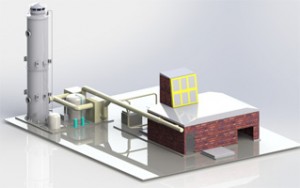 Biogas Desulfurization Systems
Biogas Desulfurization Systems
Since biogas contains a high amount of H2S, and thus corrosive, the sulphur in the biogas has to be removed with the necessary methods before the gas is transferred to CHP (combined heat and power generator). In order to do this, biological and/or chemical desulphurization units are utilized. The quantity of biogas to be treated and the amount of sulphur that the biogas has are crucial elements that affect greatly the choice between biological and chemical methods. Usually biological methods are preferred since they have no chemical consumption, and since they present less expenditure for businesses.
Biological and Chemical Deodorization Systems
The primary reasons for the odor problem which is one of the environmental effects of the industrial and domestic wastewater treatment facilities are intake structure, sludge thickening and decomposing pools, sludge dewatering units, transferring the dewatered sludge, and storing it.
The systems set up to decrease or completely remove the odor caused by the manufacturing processes in the wastewater treatment facilities and in industry are deodorization process.
Chemical deodorization process is based on the principle of alteration of the molecular structure of the emissions with an odor by a chemical material. Scrubbers with wet filters are thus utilized.
Biological deodorization treatment process, however, treats emissions with odor in biotrickling filter systems by using sulphur bacteria in the sewer system, and deodorizes at low cost.
